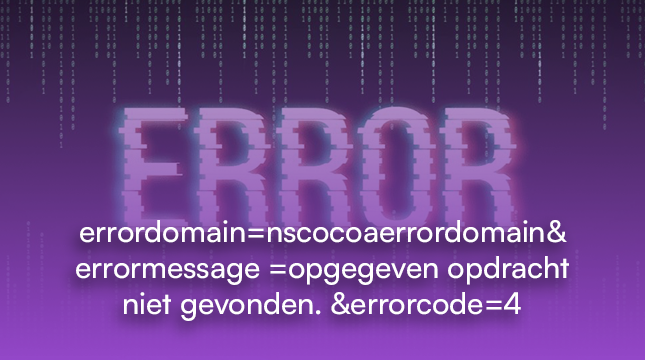Have you ever encountered a cryptic error message like “errordomain=nscocoaerrordomain&errormessage=opgegeven opdracht niet gevonden.&errorcode=4” on your computer screen? It can be frustrating, especially when it disrupts your workflow. But fear not, for this guide will demystify this error and equip you with the knowledge to tackle it effectively.
What is the “errordomain=nscocoaerrordomain&errormessage=opgegeven opdracht niet gevonden.&errorcode=4” Error?
Let’s break down this seemingly complex message into simpler parts:
- errordomain=nscocoaerrordomain: This indicates the source of the error lies within Apple’s Cocoa frameworks, which are fundamental building blocks for macOS applications.
- errormessage=opgegeven opdracht niet gevonden.: This Dutch phrase translates to “given command not found.” Here’s the crux of the issue – the application is trying to execute a specific command, but for some reason, it can’t locate or understand it.
- errorcode=4: This numeric code serves as an internal reference for developers to pinpoint the exact nature of the problem within the code.
Read More : errordomain=nscocoaerrordomain&errormessage=could not find the specified shortcut.&errorcode
Understanding the Jargon
Here’s a quick explanation of the technical terms used:
- nscocoerrordomain: This refers to the domain (source) of the error, which in this case, is related to Apple’s Cocoa frameworks used in macOS applications.
- opgegeven opdracht niet gevonden.: This Dutch message simply means “command not found.” Don’t worry if you don’t speak Dutch; the meaning is conveyed through the overall message.
- errorcode: This is a unique code assigned by the program to identify the specific type of error encountered.
When Does This Error Occur?
This error can appear under various circumstances, but some common scenarios include:
- Application Issues: The application itself might be experiencing internal bugs or glitches that prevent it from recognizing the intended command.
- System Conflicts: Sometimes, conflicts with other software running in the background can disrupt communication between the application and the operating system, leading to this error.
- Outdated Software: Outdated software versions often lack critical bug fixes and updates that address known compatibility issues. Running an outdated application can trigger this error.
Read More :Meet the Woodstock Couple: From Festival-Goers to Forever Entwined with History
What Does the Error Mean?
Essentially, this error signifies a communication breakdown between the application and your computer’s operating system. The application is trying to tell the system to perform a specific task (the “command”), but the system can’t find or understand that instruction. Imagine you’re trying to give someone a specific direction, but they speak a different language or simply can’t comprehend your request. That’s the analogy for what’s happening here.
- The Missing Command: codebase due to a bug or corruption, or the application is attempting to execute a command that’s no longer supported by the current system configuration.
- Communication Breakdown: Alternatively, the communication channel between the application and the operating system might be malfunctioning. This could be due to temporary glitches, conflicting software, or even corrupted system files.
How to Fix the “errordomain=nscocoaerrordomain&errormessage=opgegeven opdracht niet gevonden.&errorcode=4” Error
Now that we understand the meaning behind the error, let’s explore some solutions to get you back on track:
Basic Troubleshooting Steps
These initial steps are often effective in resolving the issue:
- Restart the Application: A simple restart can often clear temporary glitches and refresh the application’s communication with the system.
- Check for Updates: Outdated software can be a culprit. Make sure you’re running the latest version of the application by checking for updates within the program’s settings or from the developer’s website.
- Clear Temporary Files: Temporary files can sometimes become corrupted and cause conflicts. Clearing your application’s cache and temporary files can help eliminate this potential roadblock.
Advanced Solutions (for Technically Savvy Users)
If the basic steps don’t solve the problem, these advanced solutions might be necessary (proceed with caution if you’re not comfortable with technical procedures):
- Reinstalling the Application: Sometimes, a clean reinstall can fix issues caused by corrupted application files. Remember to back up any important data before reinstalling.
- Resetting System Permissions: In rare cases, corrupted system permissions can interfere with application functionality. Resetting permissions can potentially resolve the issue, but it’s recommended to research the specific steps for your operating system beforehand.
- Verifying Disk Integrity: Disk errors can also lead to unexpected behavior. Running a disk integrity check can identify and potentially fix any underlying issues.
Remember: These advanced solutions require a certain level of technical expertise. If you’re unsure about any step, it’s best to consult a tech-savvy friend or seek professional help.
Additional Tips and Considerations
Here are some additional points to keep in mind:
Identifying the Affected Application
Pay attention to which application throws the error message. This will help you narrow down the troubleshooting process and determine if the issue is specific to that program or a system-wide problem.
macOS vs. Windows Users
While the error message itself might appear on both macOS and Windows systems, the solutions will differ based on your operating system. This guide primarily focuses on troubleshooting for macOS users, as the error message originates from Apple’s Cocoa frameworks.
Seeking Professional Help
If the error persists after trying all the solutions mentioned above, it might be wise to seek assistance from a qualified computer technician or the application’s developer support team. They can provide more specific guidance based on the application and your system configuration.
Conclusion
The “errordomain=nscocoaerrordomain&errormessage=opgegeven opdracht niet gevonden.&errorcode=4” error can be frustrating, but by understanding its meaning and following the provided troubleshooting steps, you can often resolve it effectively. Don’t hesitate to seek professional help if the problem persists. Remember, a little patience and the right approach can get you back to using your applications smoothly.

